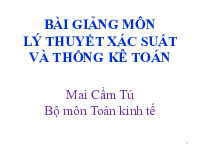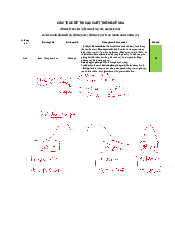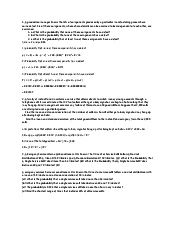









Preview text:
NATIONAL ECONOMICS UNIVERSITY BUSINESS SCHOOL
Probability & Mathematical Statistic
Topic: The change in income in Dong Thap and Kien Giang in 2010 and 2014 EBBA 12.2 Group 13 Nguyễn Ngọc Tân 11203496
Nguyễn Thị Thu Thảo 11194835
Nguyễn Việt Hằng 11181537 Đổng Thị Duyên 11181173 1 Table of contents Introduction 3
The change in income in Dong Thap from 2010 to 2014 4
The change in income in Kien Giang from 2010 to 2014 6
The change in income in Dong Thap and Kien Giang from 2010 to 2014 8 Conclusion 9 2 INTRODUCTION About Dong Thap
Dong Thap Province shares a 48-kilometer stretch of northern border with one Cambodian
province named Pray Veng, borders Vinh Long and Can Tho to the south, An Giang to the
west, and Long Giang, Tien Giang to the east.
The capital city of Dong Thap is Cao Lanh, which is located 162km away from Ho Chi Minh
City. With a total area of 3376.4 km2 and a population of 1667.8 thousand people (2006), this
is one of the most important provinces in southern Vietnam. About Kien Giang
Kiên Giang is a province of Vietnam, located in the Mekong Delta region of southern
Vietnam. It is known for fishing and rice farming. The provincial capital is Rạch Giá, 155 mi
(249 km) from Ho Chi Minh City. Kiên Giang's area is about 6,299 km² and its population is
about 1,634,043, of which 22 percent live in urban areas.
Kiên Giang is bordered with An Giang Province in the northeast, Cần Thơ and Hậu Giang
provinces in the east, Bạc Liêu Province in the southeast and Cà Mau Province in the south,
and Kampot Province of Cambodia (with the 33 mi (53 km) border) in the west, and the Gulf
of Thailand in the southwest (with the 124 mi (200 km) coast).
According to survey results on April 1, 2009, Kiên Giang province's population is 1,683,149 people 3
THE CHANGE IN INCOME IN DONG THAP FROM 2010 TO 2014
The average income per head between urban and rural areas in 2010, 2012, 2014 in Dong Thap.
The chart above shows the income per head between urban and rural areas for the years 2010, 2012 and 2014 in Dong Thap.
As can be seen, personal income in Dong Thap increased slightly from 2010 to 2014 and
income per head in urban areas is always much larger than in rural areas. Specifically, it
increased from 27.5 million in 2010 to more than 39 million per capita in 2014 in urban
areas. In rural areas, from 14.6 million in 2010 to 25.2 million in 2014.
The distribution of Income per head of 168 households in Dong Thap. 4
This particular graph shows the distribution of annual income per capita of 168 samples over
a 3-year period (2010, 2012 and 2014).
According to the chart above, all three of these datasets have the same sample size N = 168.
The information can be analyzed using the central propensity measure. Specifically, the mean
(X from the graph) shows the per head income/year of 168 households. It can be clearly seen
that the gap between 2012 and 2014 is quite large.
Moreover, income per head is concentrated in the range of VND 16.9 million to VND 130.8
million in 2010, about VND 21.1 million to VND 126.3 million in 2012, and VND 27.7
million to VND 136.1 million in 2014. In 2012 and 2014 there were two huge differences
between 217.1 million VND and 192.9 million VND. These two exceptions cause the box
plot to fluctuate over a fairly large range.
Through the box plot of the 3-year period, it can be seen that all histograms are right -
skewed with sk > 0 (skewness) and mean > median.
Income per head between the poorest & the richest 5
In 3 years (2010, 2012 and 2014), the gap between richest and the poorest is large.
Meanwhile, 2010 has the smallest gap. It can be seen that this gap has increased from 2010 to 2014.
Meanwhile, the bar chart compares the difference in incomes per head of the poorest and
richest people. From the graph, both the highest earners and the lowest earners earned more
over the course of 3 years (2010, 2012 and 2014). The average income of the poorest
increased slightly from about 5.7 million VND to nearly 10 million VND in the period 2010-
2014. During the same period, the average income of the richest increased from 42.6 million
VND to 67 million. Therefore, the gap between the richest and the poorest quintile is still quite large.
THE CHANGE IN INCOME IN KIEN GIANG FROM 2010 TO 2014
Kien Giang - Income per head
The bar chart below illustrates the average income per head in Kien Giang province by area
over the years 2010, 2012 and 2014. 6
In general, the average income per head in urban areas in Kien Giang is always much larger
than in rural areas. Per capita income has also increased over the years whether in rural or urban areas.
More specifically, in 2010, people in urban areas earned 24.96 million VND on average,
while in rural areas this figure was 13.13 million VND, which is 52,6% smaller than in urban areas.
In 2012, the average income per head in urban areas increased to 23.33 million VND(nearly
doubling) compared to 2010, reaching 48.29 million VND. In rural areas, this figure only
increased slightly, about 5.4 million VND compared to that of two years ago.
In the next two years, per capita income in rural areas increased more than in urban areas. In
rural areas, per capita income increased from 18.53 million VND to 25.38 million VND,
increasing to 6.85 million VND. Meanwhile in urban areas, per capita income has increased
to 3.98 million VND, from 48.29 million in 2012 to 52.27 million in 2014.
Kien Giang - Income per head distribution. 7
It can be seen that the chart above is a right-skewed chart and the out-liner of the box plot in
2012 and 2014 is extremely large.
Per capita income is concentrated in the range of 7.61 million to 19.93 million VND in 2010,
10.9 million to 26.62 million VND in 2012 and 14.03 million to 33.54 million VND in 2014.
The median increased from 10.91 million to 21.10 million within 5 years. The smallest per
capita income in 2012, was 4.52 million VND, by 2014 this figure had decreased to 2.99 million VND.
In 2012 and 2014, two very large outliers appeared, 779.69 million VND and 816.7 million
VND. These two outliers caused the box plot to fluctuate in a very large range.
Kien Giang - Income per head between the poorest and the richest. 8
The column chart above has shown an extremely large disparity of average income per head
between the poorest and richest in Kien Giang in 2010, 2012 and 2014.
The average income per head of the richest in 2010 was 37.8 million VND, in 2012 was
74.39 million VND (nearly doubled), in 2014 was 80.64 million VND (an increase of 2.1
times compared to 2010). Meanwhile, this figure of the poorest continuously was 5.63
million, 8.52 million and 10.24 million VND through each of 2010, 2012, 2014. The average
per capita income of the poorest has not increased significantly within half a decade, although
in 2012 this figure increased to 36.59 million VND compared to 2010 for the richest.
THE CHANGE IN INCOME BETWEEN DONG THAP AND KIEN GIANG FROM 2010 TO 2014. 9
According to the chart, it can be seen that the gap between the rich and the poor in the two provinces is quite clear.
Specifically, in 2010 and 2014, the income of the richest people in Dong Thap was higher
than in Kien Giang. But by 2012, the richest income of Kien Giang was larger than that of Dong Thap.
In addition, The income of the poorest of Dong Thap and Kien Giang in 2010 - 2014
increased (5,63mil to 10.2mil in Dong Thap and 5.7mil to 9.7mil in Kien Giang). The income
of the richest in Dong Thap increased over 3 years, and in Dong Thap, it decreased in 2012 -
2014 ( 74.39mil to 67mil). It can be seen that the income growth rate of the rich is very large.
Although the income of the poorest always increases, The gap between rich and poor is widening. CONCLUSION
About Dong Thap, in terms of the average income per head, urban areas have a greater
number than rural areas, which is quite understandable. From 2010 to 2014, the gap between
the poor and the rich keeps getting larger: the rich become richer as the poor find their life conditions more difficult
When it comes to the growth pace between rural areas and urban areas, Kien Giang is the
same as Dong Thap: Urban areas out-grow the rural areas. However, the rich in Dong Thap
might consider the 2012-2014 period a hard time since their income decreased steadily over the course of 2 years.
There is no such conclusion about which factors lead to such change in data since there are a
lot of conditions to consider (in terms of social, technology, economic trends etc). There is no
such specific event to put the responsibility on.
However, it is necessary to acknowledge the universal tendency that the gap between the rich
and the poor keeps getting bigger. The Government needs to take some measures to deal with
these issues. This is not simply an economic to statistical issue, this is a social one as well,
and it directly impacts the well being of people. 10




